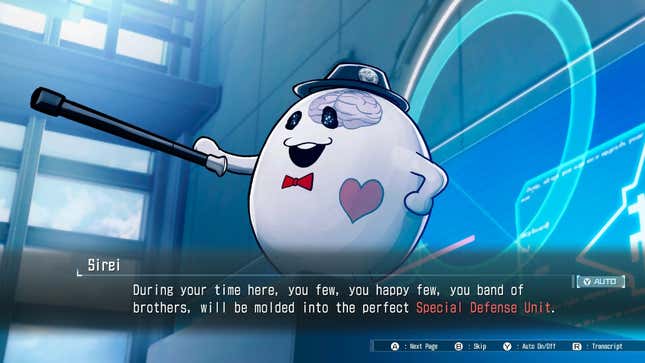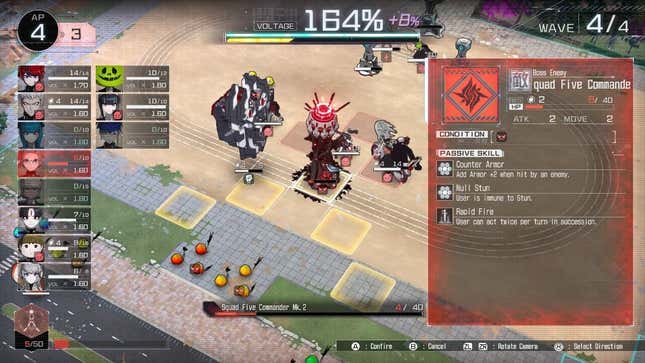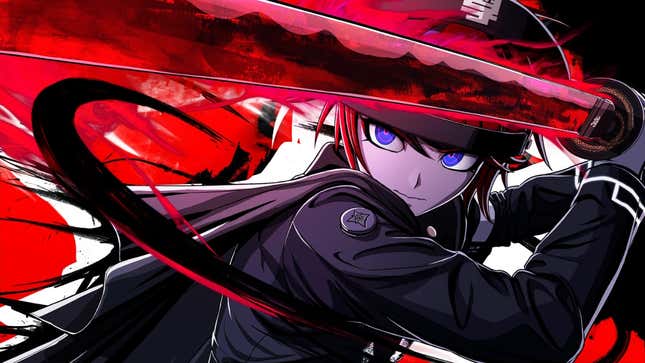The Hundred Line Is Danganronpa And Zero Escape’s Final Form
When Danganronpa creator Kazutaka Kodaka and Zero Escape director Kotaro Uchikoshi joined forces to found Too Kyo Games in 2017, I was curious to see just what the two legends of so-called “death games” would create together. But although the team has put out several games in just under a decade, none of them have quite felt like a collaborative effort bearing the distinct creative fingerprints of both creators, until now. The Hundred Line: Last Defense Academy may not be a death game like the duo’s previous work, but the tactical RPG is still overflowing with both Kodaka and Uchikoshi’s signature twists, turns, over-the-top characters, and bold design elements that have made each of their works memorable.
I’m about 30 hours into The Hundred Line, and for much of that time its premise is classic Kodaka, to the point where I was curious if it might turn out to be a secret Danganronpa game masquerading as something new. A group of teenagers living in a Tokyo complex are attacked by a strange alien invasion, and to help them face this threat, a weird little ghost-like mascot named Sirei gives each of them a blade that activates a mysterious power within them. Called hemoanima, these powers manifest as different weapon types that are an extension of each character’s personalities. The group is then trapped in the titular Last Defense Academy and told they must defend the school from the invading forces for 100 days. Only then will they be allowed to go home.
Everything about Hundred Line screams Danganronpa spin-off, even if officially it isn’t. The teenagers locked in a school by a devious mascot premise is one major similarity, but the game also features the same artist and composer as the murder mystery series. So despite its differences, it still has the same vibe. Initially I wasn’t sure what to make of this because Kodaka has made a career out of being self-referential. Each Danganronpa game paid homage to the previous one in ways that went beyond narrative throughlines. 2023’s Master Detective Archives: Rain Code may have told a more noirish supernatural tale, but the underlying murder mystery structure was nearly a 1:1 recreation of Danganronpa, right down to the mechanics you used to solve its crimes. When nearly everything a game developer has done has been a callback to his defining work, you start to wonder if the guy only has, like, two ideas.

While the derivative nature of Hundred Line was distracting at times, I can’t deny it scratched an itch. Kodaka’s brand of high-stakes drama juxtaposed with zany dark humor is still a winning formula, and although the sci-fi mystery it tells is maybe not as immediately compelling as his previous work, it goes in some wild directions that kept me guessing. However, with all the good comes some of Kodaka’s known quirks that you may or may not find grating if you’ve followed his work. While half the cast of trapped high schoolers meaningfully drive the plot forward, the other half serve mostly to derail serious conversations with obnoxious one-liners. For most of the game I wasn’t able to really get to know them because Hundred Line’s social elements are severely lacking compared to those in Kodaka’s previous work, but more in-depth conversations unlocked later which I’m still chipping away at. Even without those extra conversations, however, the cast is full of standouts like the brute with a heart of gold Takemaruand the unnerving assassin Yugamu. Even the characters who initially seemed like one-note tropes wormed their way into my heart eventually.
All of those different personalities manifest in different fighting styles for the game’s tactical combat. Invading forces will periodically attack the Last Defense Academy, and over the course of the game you’ll have to convince hesitant classmates to join the war effort. As your party grows, so do the challenges you’ll face. For the most part, Hundred Line’s big story battles are spaced out enough that each feels significant, and there are few enough of them that even the most challenging don’t overstay their welcome. If you’re the type of person who wants a Kodaka or Uchikoshi story but doesn’t consider yourself much of a tactical RPG connoisseur, fear not: Hundred Line’s battles feel more like puzzles than the more demanding combat in something like XCOM or Baldur’s Gate 3.

The crux of Hundred Line’s tactical battles is its AP system. These action points are what allow you to make someone on your team cast an ability, defend an objective, or even move across the battlefield. You’ll start out with only a few of these per turn, but defeating mid-level or higher-ranking enemies on the field will grant you more. As the battle progresses your team gets access to their ultimate abilities, which typically deal high damage to a large area on the field and can take out several enemies at once. These led to the most rewarding moments of Hundred Line’s battles for me, as I chained different party members’ ultimates together to give the rest of my team more chances to pull off a decisive attack.
One of my favorite fights came about midway through Hundred Line when the school was being attacked by a powerful Commander unit. They had nearly taken down my defenses and would have won the fight if I didn’t end the battle in one turn. Luckily, when a character reaches a certain low health threshold, they’re able to cast their ultimate as a final sacrifice, dealing devastating damage to the field but taking themselves out of the fight. By this point several of my characters were a light pat from death, but in my ranks I also had Kyoshika, the katana-using samurai with a passive ability that allowed her to do extra damage to enemies who were “alone” on the field and not surrounded by any of their teammates. At this point, I knew I had to take a scorched earth approach to the battle to emerge victorious. I sacrificed several of my teammates, using their self-destructive ultimates to take out several mid-level foes and give my team more AP. After I’d lost several of my crew, I had more than enough actions saved up for Kyoshika to whale on the lone Commander, with each strike more than doubled in power because of her passive ability. Doing this meant I was just barely able to win the fight, all because I was willing to sacrifice pawns and made do with what I had left. That kind of table-turning problem-solving feels great, and it was rewarding to see my understanding of one character’s strengths win me the fight. Those kinds of plays only became more common as the game went on and I unlocked new characters with their own specialties. Sure, it’s not as deep or daunting as some of the genre’s biggest names, but it’s got the juice.

I’ve mentioned that Hundred Line feels like Kodaka’s greatest hits, for good and ill, but I haven’t touched on how Zero Escape’s DNA is clearly running through the game. That’s because the extent of Uchikoshi’s influence is pretty hidden for much of its run, and explaining it would rob you of some of the boldest swings the team takes. It’s why despite hitting the credits, I’m still not quite ready to dive into everything the game has to say and stamp “The Kotaku Review” on this write-up. I’ve been pulled away from Hundred Line by other obligations, but getting back to it is all I’ve been thinking about. If you’re a fan of Danganronpa or Zero Escape, know that even with the switch-up in genre, this is a true marriage of some of the best parts of both games.














Post Comment